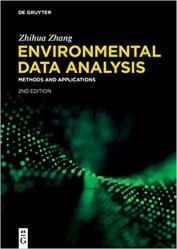 Название: Environmental Data Analysis: Methods and Applications, 2nd Edition
Название: Environmental Data Analysis: Methods and Applications, 2nd EditionАвтор: Zhihua Zhang
Издательство: De Gruyter
Год: 2023
Страниц: 400
Язык: английский
Формат: pdf (true), epub
Размер: 50.1 MB
There are some books that target the theory of the finite element, while others focus on the programming side of things. Introduction to Finite Element Analysis Using MATLAB and Abaqus accomplishes both. This book teaches the first principles of the finite element method. It presents the theory of the finite element method while maintaining a balance between its mathematical formulation, programming implementation, and application using commercial software. The computer implementation is carried out using MATLAB, while the practical applications are carried out in both MATLAB and Abaqus. MATLAB is a high-level language specially designed for dealing with matrices, making it particularly suited for programming the finite element method, while Abaqus is a suite of commercial finite element software.
- Includes more than 100 tables, photographs, and figures
- Provides MATLAB codes to generate contour plots for sample results
To deeply mine features and quickly capture useful information inside environmental big data, in the second edition of our book “Environmental Data Analysis: Methods and Applications”, we add emerging network models: neural networks, complex networks, downscaling analysis and streaming data on networks. Neural networks can imitate nonlinear non-stationary hidden links inside the environmental system through a learning process and then make exact predictions, but they do not need to directly extract these hidden links. Complex networks can fill gaps in understanding complex nonlinear dynamical processes governing the environmental system. Changes in environmental evolution over time can be detected by local, global, topological, and spectral structures of associated networks. Downscaling analysis can overcome the sparsity of environmental monitoring sites and produce a high-resolution environmental evolution map. Streaming data on networks can reveal the complexity of dynamic environmental evolutions and make near-real-time management and decisions. All these models and algorithms have been rapidly developed since the release of the first edition of our book.
Networks are becoming an emerging brand-new tool to fill gaps in understanding the complex nonlinear dynamical processes governing environmental process. Unlike traditional data analysis, the network approach can reveal topology structures of environmental systems and extract nonlinear non-stationary hidden links over a wide range of spatial/temporal scales. In this chapter, we will focus on neural networks, complex networks, downscaling analysis, and streaming data on networks.
A neural network is a massively parallel distributed processor that works much like human brains. Neurons in a neural network are designed as nonlinear information-processing units, and the interactions between neurons are mediated by synapses. Neural networks can recognize hidden patterns and correlations in raw environmental data through various Deep Learning algorithms.
Introduction to Finite Element Analysis Using MATLAB and Abaqus introduces and explains theory in each chapter, and provides corresponding examples. It offers introductory notes and provides matrix structural analysis for trusses, beams, and frames. The book examines the theories of stress and strain and the relationships between them. The author then covers weighted residual methods and finite element approximation and numerical integration. He presents the finite element formulation for plane stress/strain problems, introduces axisymmetric problems, and highlights the theory of plates. The text supplies step-by-step procedures for solving problems with Abaqus interactive and keyword editions. The described procedures are implemented as MATLAB codes and Abaqus files can be found on the CRC Press website.
Скачать Environmental Data Analysis: Methods and Applications, 2nd Edition